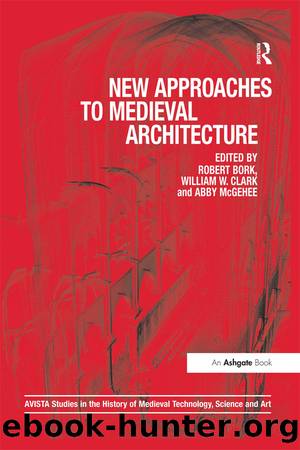New Approaches to Medieval Architecture by Bork Robert. Clark William W. McGehee Abby

Author:Bork, Robert.,Clark, William W.,McGehee, Abby.
Language: eng
Format: epub, pdf
Publisher: Taylor & Francis (CAM)
Figure 8.5 Saint-Ãtienne, Bourges Cathedral. South lateral portal, right jamb 2,3; ca. 1155â60
Figure 8.6 Notre-Dame, Chartres Cathedral. Royal Portal west facade, centre portal, left jamb, 3, 2, 1; ca. 1145â55
The compositions of column-figures can be described briefly: (1) in fifty column-figures, the hand on the left is up, while the hand on the right is at midbody; (2) in thirty-eight column-figures, both hands reach to the centre, around the waist level; (3) in twenty-nine column-figures, the hand on the left is down at hip level, while the hand on the right is up; (4) in eight column-figures, the hand on the left is at the side of the body and the hand on the right is at midbody; (5) in seven column-figures, both hands are down; (6) in four column-figures, the hand on the left is up while the hand on the right is down at the side; (7) in four column-figures, the hand on the left is at mid-body and the hand on the right is at the side of the body.
No matter which of the three rough-block forms was used, in each instance the ymagiers composed the figure within the block so that the column behind the figure could be shaped as a column and set in place along the facade (see Figures 8.7, 8.3). This innovative arrangement produces greater depth and width for the figure: the diagonal of a 15- by 15-inch block is just over 21 inches, with nearly three-quarters of the block protruding into space.20 On the facades of Ãtampes and Provins these massive en-delit shafts were set inches away from the facades, though at Bourges and Vermenton the column-figures addorsed to their columns were secured snugly within a niche (see Figures 8.5, 8.4). A sequence of work suggests itself: the composition of the figure(s) would have been planned by an ymagier; once the ymagier had located the centreline of the figure, the conventional rough-cut formula to be followed could be determined and roughed-out blocks could be requisitioned from the quarry that would be shipped in the appropriate quantity to the chantier. Finally, these roughed-out standard blocks of limestone could be shaped by assistants, with minimal waste, and finished under the direction of the ymagier who had planned the figure(s). This workshop organization and the division of labour can be discerned in the standardization of column-figure forms: the basic shape of the blocks from which column-figures were made could be carved in a conventional way by teams of ymagiers, suiting the design planned for the finished column-figure. The different tasks of layout, basic forms, fine textiles, hands, faces, hair, etc., might have been assigned to members of teams within the workshop according to expertise and experience. A striking sculptural detail suggests that the figure was shaped before the column: the textiles of the lower mantles and skirts were extended into space, around the column, on the figure of Peter in the interior chapel at Ãtampes (Figure 8.9), a detail that also appears on women column-figures on the outer jambs of the Royal Portal of Chartres (Figure 8.
Download
New Approaches to Medieval Architecture by Bork Robert. Clark William W. McGehee Abby.pdf
This site does not store any files on its server. We only index and link to content provided by other sites. Please contact the content providers to delete copyright contents if any and email us, we'll remove relevant links or contents immediately.
| Ancient & Classical | Greek |
| Medieval | Roman |
Letters From a Stoic by Seneca(2721)
The Valmiki Ramayana: Vol. 1 by Bibek Debroy(2375)
The Valmiki Ramayana: Vol. 2 by Bibek Debroy(2234)
The Valmiki Ramayana: Vol. 3 by Bibek Debroy(2119)
Mary Boleyn by Alison Weir(1834)
The Greeks by H. D. F. Kitto(1697)
The Notebooks of Leonardo Da Vinci by Da Vinci Leonardo(1548)
The Classics by Mary Beard(1524)
Mythos (2019 Re-Issue) by Stephen Fry(1505)
The Voynich Manuscript by Gerry Kennedy(1433)
Medea and Other Plays by Euripides(1389)
Art of Living by Sellars John;(1387)
Annals by Tacitus(1363)
Hindoo Holiday by J. R. Ackerley(1295)
Claudius the God by Robert Graves(1254)
Appeasement of Radhika by Muddupalani(1233)
Atlantis the Lost Continent Finally Found by Arysio Santos(1207)
THE REPUBLIC by plato(1196)
Kadambari: Bana by Bana(1195)
